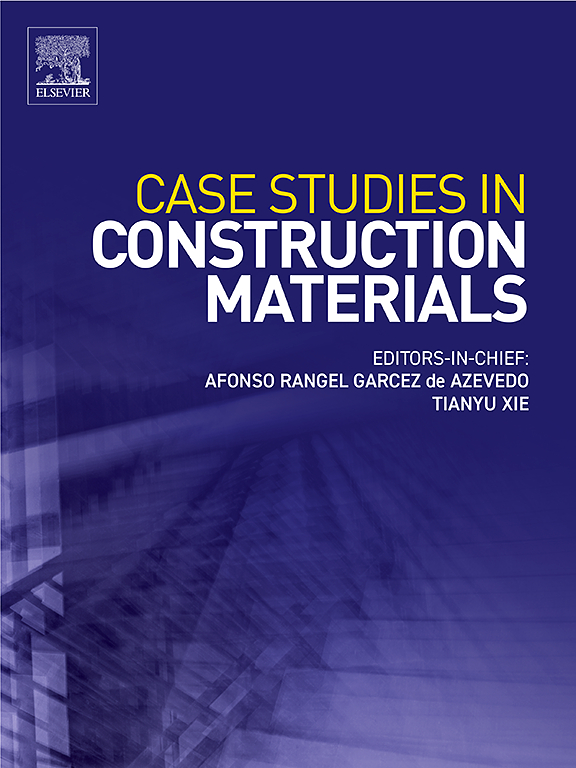石英和磷杂质对可持续超硫酸盐磷石膏渣水泥水化过程及早期性能的影响
IF 6.6
2区 工程技术
Q1 CONSTRUCTION & BUILDING TECHNOLOGY
引用次数: 0
摘要
超硫酸盐磷石膏矿渣水泥(EPSC),含有40-60 %磷石膏(PG),在稳定有害杂质的同时,为磷石膏的处置提供了可持续的解决方案。然而,磷石膏中典型的杂质,如石英和磷,严重阻碍了EPSC的硬化动力学,影响了EPSC的早期强度发展,从而制约了EPSC的实际应用。采用与磷石膏相似的石英粒度分布研究了石英对EPSC性能的影响。通过HNO3调节石膏pH,系统考察了初始碱度对EPSC水化的影响,深入分析了磷酸盐掺杂对EPSC硬化和水化机理的影响。结果表明,用石英代替10.42 %的石膏可保持EPSC中硫酸盐的过饱和浓度,对水化过程的影响可以忽略不计。初始pH抑制对矿渣的早期溶解有短暂的抑制作用,但对矿渣的早期溶解无长期影响。磷酸盐杂质通过Ca2+封存破坏了石膏的溶晶平衡,在初始水化阶段抑制了42.9% %的Ca2+释放,14.6% %的晶体变粗。结果表明,磷杂质会影响石膏的溶解、结晶形态和水泥熟料的水化,延缓GGBS的活化,严重影响EPSC的凝结硬化。本文章由计算机程序翻译,如有差异,请以英文原文为准。
Influence of quartz and phosphorus impurities on hydration process and early-age properties of sustainable excess-sulphate phosphogypsum slag cement
Excess-sulphate phosphogypsum slag cement (EPSC), incorporating 40–60 % phosphogypsum (PG), offers a sustainable solution for phosphogypsum disposal while stabilizing hazardous impurities. However, typical impurities in phosphogypsum, such as quartz and phosphorus, significantly impede the hardening kinetics and compromise early strength development of EPSC, thereby constraining its practical application. The influence of quartz on EPSC properties was investigated using quartz with particle size distributions analogous to those found in phosphogypsum. By employing HNO3 to modulate gypsum pH, the impact of initial alkalinity on EPSC hydration was systematically examined, followed by an in-depth analysis of phosphate doping effects on the hardening and hydration mechanisms. Results revealed that substituting 10.42 % gypsum with quartz in EPSC maintains supersaturated sulfate concentrations, exerting negligible influence on hydration processes. While initial pH suppression transiently inhibited early dissolution of ground granulated blast-furnace slag (GGBS), no long-term interference was observed. Phosphate impurities impair gypsum's dissolution-crystallization equilibrium via Ca2+ sequestration, evidenced by 42.9 % suppressed Ca2+ release and 14.6 % crystallite coarsening during initial hydration stages. The results show that phosphorus impurities can affect the dissolution and crystal morphology of gypsum and the hydration of cement clinker, delay the activation of GGBS, and seriously affect the condensation and hardening of EPSC.
求助全文
通过发布文献求助,成功后即可免费获取论文全文。
去求助
来源期刊

Case Studies in Construction Materials
Multiple-
CiteScore
7.60
自引率
19.40%
发文量
842
审稿时长
63 days
期刊介绍:
Case Studies in Construction Materials provides a forum for the rapid publication of short, structured Case Studies on construction materials. In addition, the journal also publishes related Short Communications, Full length research article and Comprehensive review papers (by invitation).
The journal will provide an essential compendium of case studies for practicing engineers, designers, researchers and other practitioners who are interested in all aspects construction materials. The journal will publish new and novel case studies, but will also provide a forum for the publication of high quality descriptions of classic construction material problems and solutions.
 求助内容:
求助内容: 应助结果提醒方式:
应助结果提醒方式:


